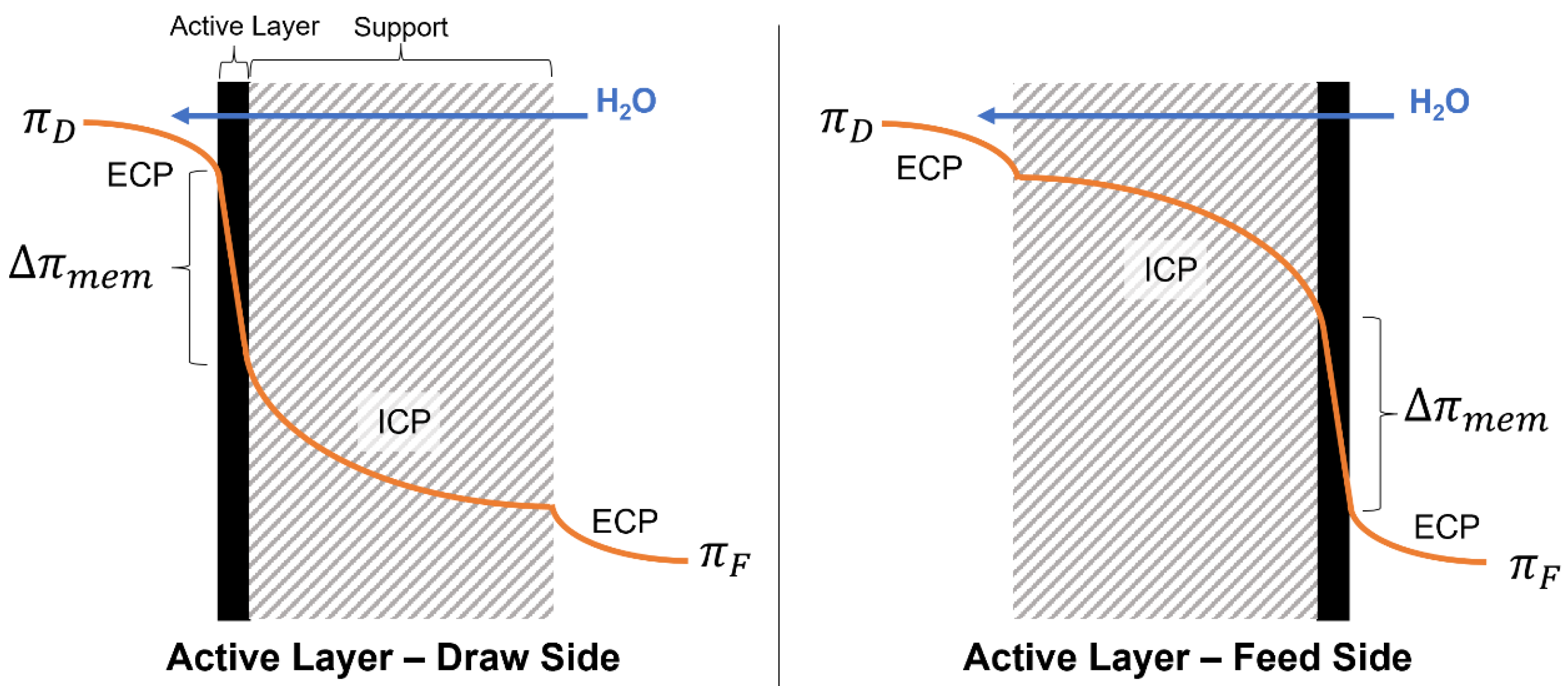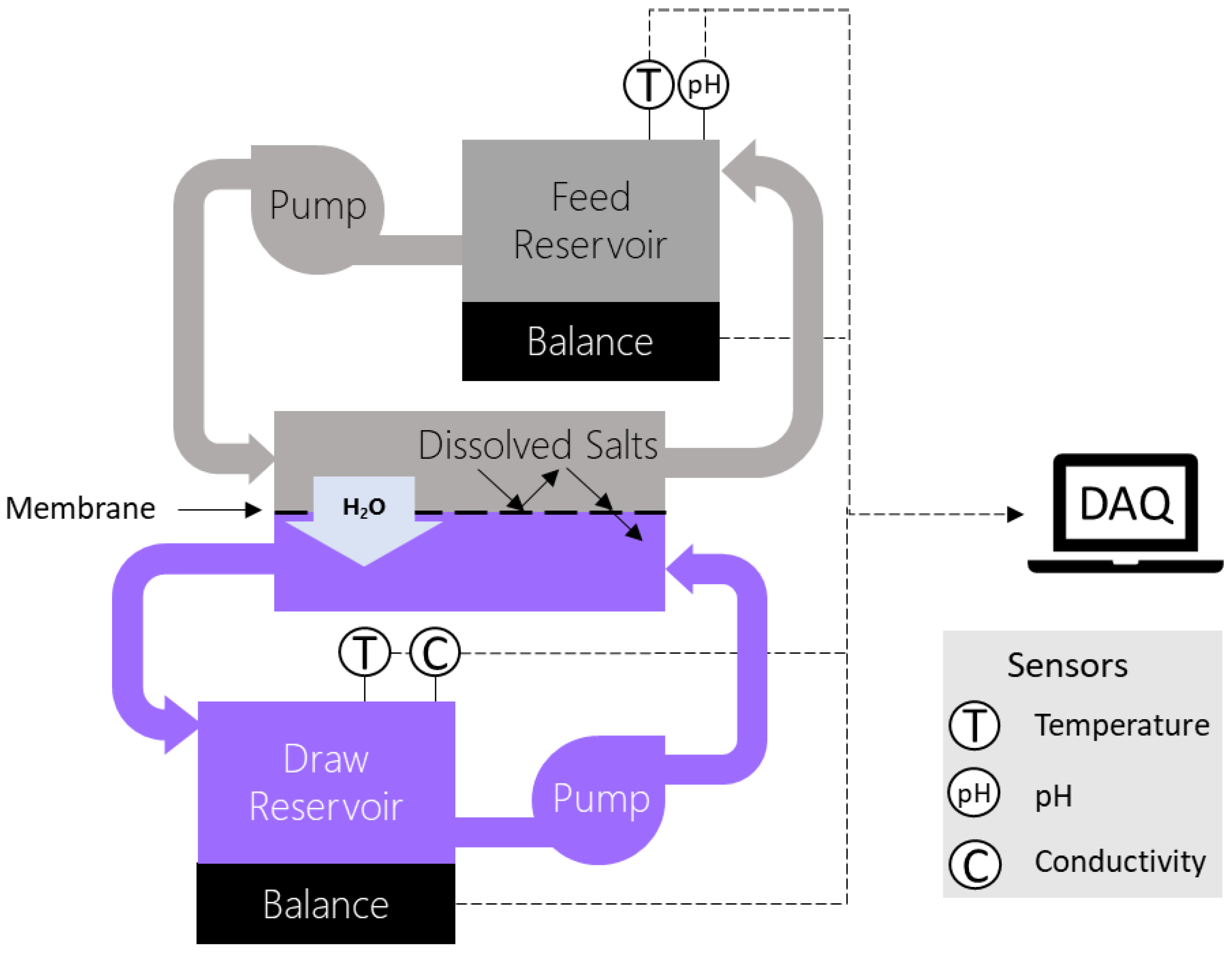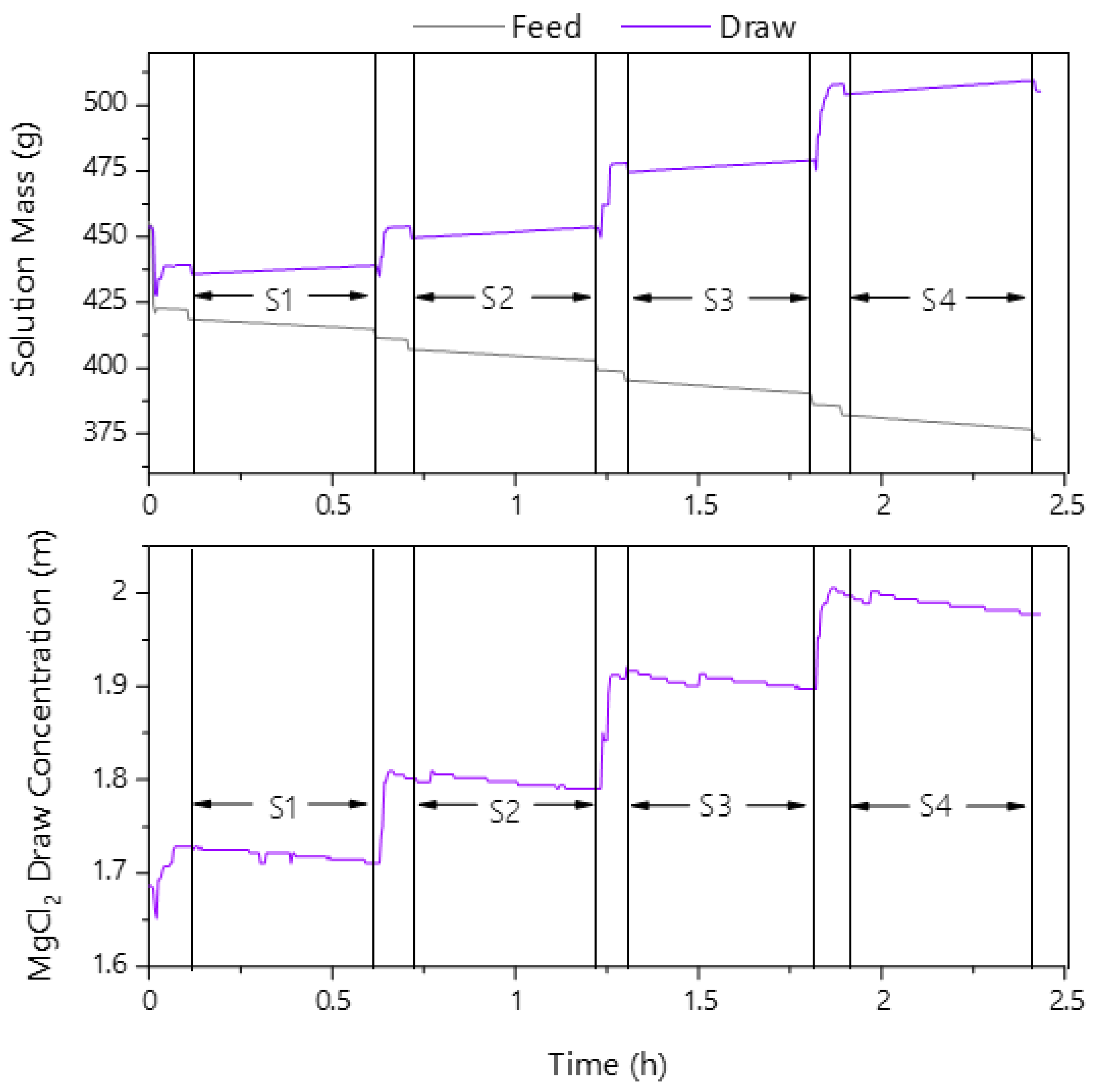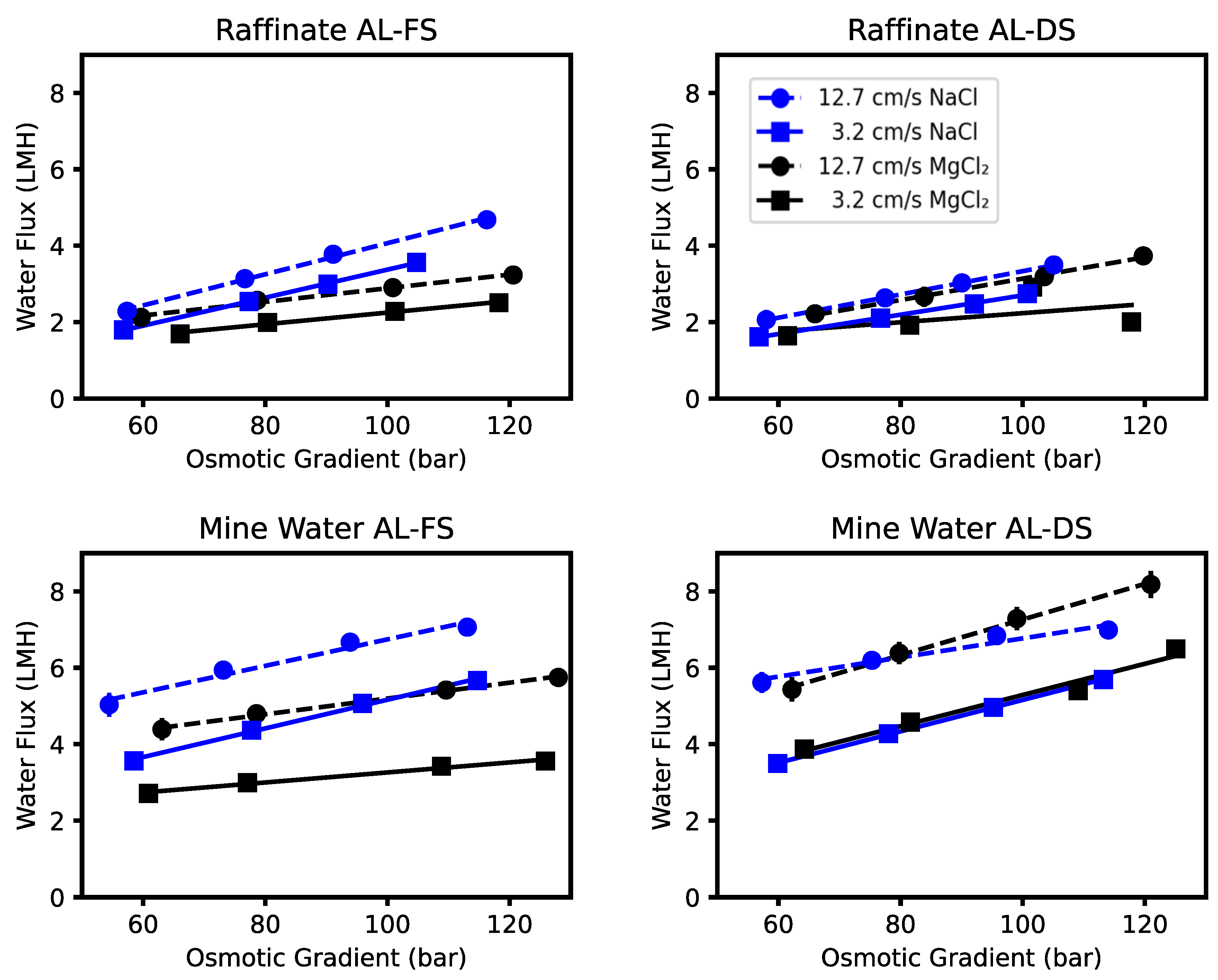Forward Osmosis for Metal Processing Effluents under Similar Osmotic Pressure Gradients
Abstract
:1. Introduction
2. Experimental Methods
2.1. Materials
2.2. Apparatus and Operation
2.3. Calculation of FO Metrics
2.4. Factorial Design
3. Results and Discussion
3.1. Water Flux
3.2. Osmotic Gradient
3.3. Crossflow Velocity
3.4. Draw Salt
3.5. Orientation
3.6. Salt Rejection
4. Conclusions
Supplementary Materials
Author Contributions
Funding
Data Availability Statement
Acknowledgments
Conflicts of Interest
References
- Statistics Canada. Table 38-10-0037-01 Water Use Parameters in Manufacturing Industries, by Industry (×1,000,000); Statistics Canada: Ottawa, ON, Canada, 2023. [Google Scholar] [CrossRef]
- Statistics Canada. Table 38-10-0066-01 Water Use Parameters in Mineral Extraction Industries, by Industry (×1,000,000); Statistics Canada: Ottawa, ON, Canada, 2023. [Google Scholar] [CrossRef]
- Al-Karaghouli, A.; Kazmerski, L.L. Energy consumption and water production cost of conventional and renewable-energy-powered desalination processes. Renew. Sustain. Energy Rev. 2013, 24, 343–356. [Google Scholar] [CrossRef]
- Mi, B.; Elimelech, M. Gypsum scaling and cleaning in forward osmosis: Measurements and mechanisms. Environ. Sci. Technol. 2010, 44, 2022–2028. [Google Scholar] [CrossRef] [PubMed]
- Yang, H.L.; Huang, C.; Pan, J.R. Characteristics of RO foulants in a brackish water desalination plant. Desalination 2008, 220, 353–358. [Google Scholar] [CrossRef]
- Kolliopoulos, G.; Martin, J.T.; Papangelakis, V.G. Energy requirements in the separation-regeneration step in forward osmosis using TMA–CO2–H2O as the draw solution. Chem. Eng. Res. Des. 2018, 140, 166–174. [Google Scholar] [CrossRef]
- Kolliopoulos, G.; Papangelakis, V.G. Extraction of Water from Contaminated Effluents by Forward Osmosis. In Extraction 2018; Springer International Publishing: New York, NY, USA, 2018; pp. 1893–1902. [Google Scholar] [CrossRef]
- McGovern, R.K.; Lienhard V, J.H. On the potential of forward osmosis to energetically outperform reverse osmosis desalination. J. Membr. Sci. 2014, 469, 245–250. [Google Scholar] [CrossRef]
- Papangelakis, V.; Kolliopoulos, G. Systems and Methods for Forward Osmosis-Freeze Concentration (FO-FC) Purification of Contaminated Aqueous Solutions. Patent CA 3108312, 12 August 2019. [Google Scholar]
- Kolliopoulos, G.; Shum, E.; Papangelakis, V.G. Forward Osmosis and Freeze Crystallization as Low Energy Water Recovery Processes for a Water-Sustainable Industry. Environ. Process. 2018, 5, 59–75. [Google Scholar] [CrossRef]
- Kolliopoulos, G.; Xu, C.; Martin, J.T.; Devaere, N.; Papangelakis, V.G. Hybrid forward osmosis—Freeze concentration: A promising future in the desalination of effluents in cold regions. J. Water Process Eng. 2022, 47, 102711. [Google Scholar] [CrossRef]
- Wang, J.; Liu, X. Forward osmosis technology for water treatment: Recent advances and future perspectives. J. Clean. Prod. 2020, 280, 124354. [Google Scholar] [CrossRef]
- Cath, T.Y.; Childress, A.E.; Elimelech, M. Forward osmosis: Principles, applications, and recent developments. J. Membr. Sci. 2006, 281, 70–87. [Google Scholar] [CrossRef]
- Martin, J.T.; Kolliopoulos, G.; Papangelakis, V.G. An improved model for membrane characterization in forward osmosis. J. Membr. Sci. 2019, 598, 117668. [Google Scholar] [CrossRef]
- Rolf, J.; Cao, T.; Huang, X.; Boo, C.; Li, Q.; Elimelech, M. Inorganic Scaling in Membrane Desalination: Models, Mechanisms, and Characterization Methods. Environ. Sci. Technol. 2022, 56, 7484–7511. [Google Scholar] [CrossRef] [PubMed]
- Siddiqui, F.A.; She, Q.; Fane, A.G.; Field, R.W. Exploring the differences between forward osmosis and reverse osmosis fouling. J. Membr. Sci. 2018, 565, 241–253. [Google Scholar] [CrossRef]
- Morrow, C.P.; Childress, A.E. Evidence, Determination, and Implications of Membrane-Independent Limiting Flux in Forward Osmosis Systems. Environ. Sci. Technol. 2019, 53, 4380–4388. [Google Scholar] [CrossRef]
- Zhan, M.; Kim, Y.; Hong, S. Comprehensive review of osmotic dilution/concentration using FO membranes for practical applications. Desalination 2021, 515, 115190. [Google Scholar] [CrossRef]
- Mahto, A.; Aruchamy, K.; Meena, R.; Kamali, M.; Nataraj, S.K.; Aminabhavi, T.M. Forward osmosis for industrial effluents treatment—Sustainability considerations. Sep. Purif. Technol. 2020, 254, 117568. [Google Scholar] [CrossRef]
- Dou, P.; Zhao, S.; Song, J.; He, H.; She, Q.; Li, X.-M.; Zhang, Y.; He, T. Forward osmosis concentration of a vanadium leaching solution. J. Membr. Sci. 2019, 582, 164–171. [Google Scholar] [CrossRef]
- Pramanik, B.K.; Shu, L.; Jegatheesan, J.; Shah, K.; Haque, N.; Bhuiyan, M.A. Rejection of rare earth elements from a simulated acid mine drainage using forward osmosis: The role of membrane orientation, solution pH, and temperature variation. Process. Saf. Environ. Prot. 2019, 126, 53–59. [Google Scholar] [CrossRef]
- Gwak, G.; Kim, D.I.; Hong, S. New industrial application of forward osmosis (FO): Precious metal recovery from printed circuit board (PCB) plant wastewater. J. Membr. Sci. 2018, 552, 234–242. [Google Scholar] [CrossRef]
- Li, J.; Wang, M.; Zhao, Y.; Yang, H.; Zhong, Y. Enrichment of lithium from salt lake brine by forward osmosis. R. Soc. Open Sci. 2018, 5, 180965. [Google Scholar] [CrossRef]
- Pham, M.T.; Nishihama, S.; Yoshizuka, K. Concentration of lithium by forward osmosis. Hydrometallurgy 2020, 197, 105485. [Google Scholar] [CrossRef]
- Awad, A.M.; Jalab, R.; Nasser, M.S.; El-Naas, M.; Hussein, I.A.; Minier-Matar, J.; Adham, S. Evaluation of cellulose triacetate hollow fiber membrane for volume reduction of real industrial effluents through an osmotic concentration process: A pilot-scale study. Environ. Technol. Innov. 2021, 24, 101873. [Google Scholar] [CrossRef]
- Hickenbottom, K.L.; Hancock, N.T.; Hutchings, N.R.; Appleton, E.W.; Beaudry, E.G.; Xu, P.; Cath, T.Y. Forward osmosis treatment of drilling mud and fracturing wastewater from oil and gas operations. Desalination 2013, 312, 60–66. [Google Scholar] [CrossRef]
- Minier-Matar, J.; Santos, A.; Hussain, A.; Janson, A.; Wang, R.; Fane, A.G.; Adham, S. Application of Hollow Fiber Forward Osmosis Membranes for Produced and Process Water Volume Reduction: An Osmotic Concentration Process. Environ. Sci. Technol. 2016, 50, 6044–6052. [Google Scholar] [CrossRef] [PubMed]
- Nguyen, N.C.; Chen, S.-S.; Weng, Y.-T.; Nguyen, H.T.; Ray, S.S.; Li, C.-W.; Yan, B.; Wang, J. Iodide recovery from thin film transistor liquid crystal display plants by using potassium hydroxide—Driven forward osmosis. J. Membr. Sci. 2016, 520, 214–220. [Google Scholar] [CrossRef]
- Liu, X.; Wu, J.; Liu, C.; Wang, J. Removal of cobalt ions from aqueous solution by forward osmosis. Sep. Purif. Technol. 2017, 177, 8–20. [Google Scholar] [CrossRef]
- Zhu, S.; Li, M.; El-Din, M.G. Forward osmosis as an approach to manage oil sands tailings water and on-site basal depressurization water. J. Hazard. Mater. 2017, 327, 18–27. [Google Scholar] [CrossRef]
- Zhou, H. Optimisation of crystallisation parameters for lithium carbonate microcrystals based on forward osmosis (FO) process. Mater. Res. Innov. 2016, 21, 1–9. [Google Scholar] [CrossRef]
- Blais, H.N.; Schroën, K.; Tobin, J. Concentration of skim milk by forward osmosis using delactosed permeate as an innovative draw solution. Int. Dairy J. 2023, 137, 105510. [Google Scholar] [CrossRef]
- Nijmeijer, K.; Oymaci, P.; Lubach, S.; Borneman, Z. Apple Juice, Manure and Whey Concentration with Forward Osmosis Using Electrospun Supported Thin-Film Composite Membranes. Membranes 2022, 12, 456. [Google Scholar] [CrossRef]
- Oymaci, P.; Offeringa, P.E.; Borneman, Z.; Nijmeijer, K. Effect of Osmotic Pressure on Whey Protein Concentration in Forward Osmosis. Membranes 2021, 11, 573. [Google Scholar] [CrossRef]
- Tiraferri, A.; Yip, N.Y.; Straub, A.P.; Castrillon, S.R.-V.; Elimelech, M. A method for the simultaneous determination of transport and structural parameters of forward osmosis membranes. J. Membr. Sci. 2013, 444, 523–538. [Google Scholar] [CrossRef]
- Baker, R.W. Membrane Technology and Applications, 2nd ed.; John Wiley & Sons, Ltd.: Chichester, UK, 2004. [Google Scholar] [CrossRef]
- Box, G.E.P.; Hunter, J.S.; Hunter, W.G. Statistics for Experimenters: Design, Innovation and Discovery, 2nd ed.; Wiley-Interscience: Hoboken, NJ, USA, 2005. [Google Scholar]
- Klaysom, C.; Cath, T.Y.; Depuydt, T.; Vankelecom, I.F. Forward and pressure retarded osmosis: Potential solutions for global challenges in energy and water supply. Chem. Soc. Rev. 2013, 42, 6959–6989. [Google Scholar] [CrossRef] [PubMed]
- Anderko, A.; Lencka, M.M. Modeling Self-diffusion in Multicomponent Aqueous Electrolyte Systems in Wide Concentration Ranges. Ind. Eng. Chem. Res. 1998, 37, 2878–2888. [Google Scholar] [CrossRef]
- Wang, P.; Anderko, A.; Young, R.D. Modeling viscosity of concentrated and mixed-solvent electrolyte systems. Fluid Phase Equilibria 2004, 226, 71–82. [Google Scholar] [CrossRef]
- Prausnitz, J.M.; Lichtenthaler, R.N.; de Azevedo, E.G. Molecular Thermodynamics of Fluid-Phase Equilibria, 3rd ed.; Prentice Hall PTR: Upper Saddle River, NJ, USA, 1999. [Google Scholar]
- Jin, X.; Tang, C.Y.; Gu, Y.; She, Q.; Qi, S. Boric Acid Permeation in Forward Osmosis Membrane Processes: Modeling, Experiments, and Implications. Environ. Sci. Technol. 2011, 45, 2323–2330. [Google Scholar] [CrossRef] [PubMed]
- Virtanen, P.; Gommers, R.; Oliphant, T.E.; Haberland, M.; Reddy, T.; Cournapeau, D.; Burovski, E.; Peterson, P.; Weckesser, W.; Bright, J.; et al. SciPy 1.0: Fundamental algorithms for scientific computing in Python. Nat. Methods 2020, 17, 261–272. [Google Scholar] [CrossRef]
- McKinney, W. Data structures for statistical computing in python. In Proceedings of the 9th Python in Science Conference, Austin, TX, USA, 28 June–3 July 2010; Volume 445, pp. 51–56. [Google Scholar] [CrossRef]
- Pedregosa, F.; Varoquaux, G.; Gramfort, A.; Michel, V.; Thirion, B.; Grisel, O.; Blondel, M.; Prettenhofer, P.; Weiss, R.; Dubourg, V.; et al. Scikit-learn: Machine Learning in Python. J. Mach. Learn. Res. 2011, 12, 2825–2830. Available online: http://jmlr.org/papers/v12/pedregosa11a.html (accessed on 13 September 2021).
- Seabold, S.; Perktold, J. Statsmodels: Econometric and Statistical Modeling with Python. In Proceedings of the 9th Python in Science Conference, Austin, TX, USA, 28 June–3 July 2010; pp. 92–96. [Google Scholar] [CrossRef]
- The Pandas Development Team. Pandas-Dev/Pandas: Pandas. Zenodo. 2020. Available online: https://doi.org/10.5281/zenodo.3509134 (accessed on 13 September 2021).
- Hunter, J.D. Matplotlib: A 2D graphics environment. Comput. Sci. Eng. 2007, 9, 90–95. [Google Scholar] [CrossRef]






| pH Adjusted Raffinate | Mine Water | |||
|---|---|---|---|---|
| pH | 3 | 7 | ||
| Osmotic Pressure (Calculated) | 125 bar | 64 bar | ||
| Composition | mg/L | mol/kgH2O | mg/L | mol/kgH2O |
| Na+ | 55,000 | 2.52 | 16,000 | 0.70 |
| Ca2+ | 23 | 6.1 × 10−4 | 5800 | 0.15 |
| Mg2+ | 2000 | 0.09 | 2000 | 0.09 |
| Cl− | 46,000 | 1.38 | 50,000 | 1.44 |
| SO42− | 63,000 | 0.70 | 1800 | 0.02 |
| AsO43− | 16,000 | 0.12 | 0 | 0.00 |
| % Charge Imbalance | −14% | −21% | ||
| Charge Reconciliation (mol/kgH2O Na+) | 0.44 | 0.31 | ||
| pH Reconciliation (mol/kgH2O HCl) | 0.24 | 0 | ||
| Raffinate (125 Bar) | Mine Water (64 Bar) | |||
|---|---|---|---|---|
| Δπ | MgCl2 | NaCl | MgCl2 | NaCl |
| (bar) | (m) | (m) | (m) | (m) |
| 58 | 1.7 | 3.3 | 1.3 | 2.3 |
| 76 | 1.8 | 3.6 | 1.4 | 2.6 |
| 95 | 1.9 | 3.8 | 1.6 | 2.9 |
| 116 | 2 | 4.1 | 1.7 | 3.2 |
| Factors | Blocked Variables | ||||||
|---|---|---|---|---|---|---|---|
| Encoding | Osmotic Gradient | Crossflow Velocity | Draw Salt | Membrane Orientation | Feed | Membrane Sample | |
| (bar) | (cm/s) | ||||||
| −1 | 54.4 | 3.2 | MgCl2 | AL-FS | Mine Water | 1 | |
| +1 | 128.0 | 12.7 | NaCl | AL-DS | Raffinate | 2 | |
| Factor Level | Raffinate | Mine Water | ||||||||
|---|---|---|---|---|---|---|---|---|---|---|
| Factor | −1 | 1 | Δ LMH | % | Δ LMH | % | ||||
| Baseline (Average) | 2.7 | 5.3 | ||||||||
| Osmotic Gradient | 54 bar | 128 bar | 1.9 | ± | 0.4 | 67% | 2.3 | ± | 0.4 | 43% |
| Crossflow Velocity | 3.2 cm/s | 12.7 cm/s | 0.7 | ± | 0.2 | 24% | 1.8 | ± | 0.2 | 34% |
| Draw (AL-FS) | MgCl₂ | NaCl | 0.9 | ± | 0.4 | 31% | 1.6 | ± | 0.5 | 30% |
| Draw (AL-DS) | MgCl₂ | NaCl | 0.2 | ± | 0.4 | 8% * | −0.2 | ± | 0.5 | −4% * |
| Orientation | AL-FS | AL-DS | 0.2 | ± | 0.2 | 8% * | 1.0 | ± | 0.2 | 18% |
Disclaimer/Publisher’s Note: The statements, opinions and data contained in all publications are solely those of the individual author(s) and contributor(s) and not of MDPI and/or the editor(s). MDPI and/or the editor(s) disclaim responsibility for any injury to people or property resulting from any ideas, methods, instructions or products referred to in the content. |
© 2023 by the authors. Licensee MDPI, Basel, Switzerland. This article is an open access article distributed under the terms and conditions of the Creative Commons Attribution (CC BY) license (https://creativecommons.org/licenses/by/4.0/).
Share and Cite
Devaere, N.; Papangelakis, V. Forward Osmosis for Metal Processing Effluents under Similar Osmotic Pressure Gradients. Membranes 2023, 13, 501. https://doi.org/10.3390/membranes13050501
Devaere N, Papangelakis V. Forward Osmosis for Metal Processing Effluents under Similar Osmotic Pressure Gradients. Membranes. 2023; 13(5):501. https://doi.org/10.3390/membranes13050501
Chicago/Turabian StyleDevaere, Noel, and Vladimiros Papangelakis. 2023. "Forward Osmosis for Metal Processing Effluents under Similar Osmotic Pressure Gradients" Membranes 13, no. 5: 501. https://doi.org/10.3390/membranes13050501





